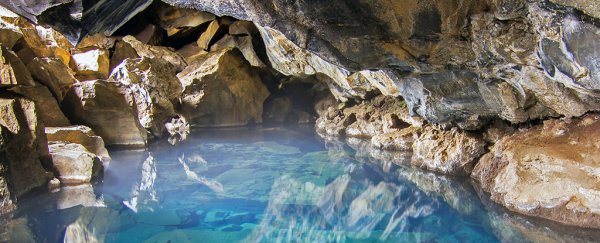Water could lie much deeper below Earth's surface than we thought, and it could tell us a lot about our planet's unique composition and future evolution.
Scientists running complex simulations on the mineral brucite, which forms part of Earth's mantle, have concluded that it can hold water under high pressure up to 595 kilometres (or 370 miles) below the surface - much deeper than earlier estimates.
Knowing how much water lies way underground can help scientists understand more about Earth's origins, and help to explain dynamic geological activity, such as volcanoes. Plus, it could give us an idea of how long the planet might take to dry up.
"This opens up a Pandora's Box for us," says one of the team, geologist Mainak Mookherjee from Florida State University.
"We didn't think water could be stored by hydrous minerals such as brucite at these depths. But now that we know it's there, we need to figure out how much water could be effectively stored inside it."
Every year, billions of tonnes of water are pushed underground through the process of subduction, where one tectonic plate rides over the top of another. It's just as important a part of the water cycle as rainfall and evaporation.
And scientists know the minerals that transport this water aren't stable enough to hold together deep underground. Once they start decomposing, the water is released, and returns to the surface via volcanic activity.
The question is, at what point do they start breaking up and releasing their liquid?
Previous research has suggested that water is released at a depth of about 300 kilometres (186 miles) based on estimates of the heat and pressure at those points, although this can vary in different areas in the mantle.
The new calculations go way beyond that, but knowing that brucite can hold water under intense pressure still doesn't tell us how much water is actually making it down to those depths - and that's the next step in the research.
And brucite is only part of the story: other hydrous minerals, such as mica, lawsonite, serpentine, could be involved as well.
Previous studies looking at the transition zone between Earth's upper and lower mantles have also suggested that water could be found way underground - as deep as 660 kilometres (410 miles) - through the mineral ringwoodite.
If there is a vast amount of water locked down there, it could explain why so much of Earth's surface is made up of water, replacing the current hypothesis that it was put there by icy asteroids.
"For the activity of the planet, deep Earth water is equally important to water on the surface," says Mookherjee.
"My goal is to understand how much water is stored in the deep Earth. If the planet becomes dry on the inside, the planet dies because geodynamic activity within the planet ceases."
The findings have been published in PNAS.
